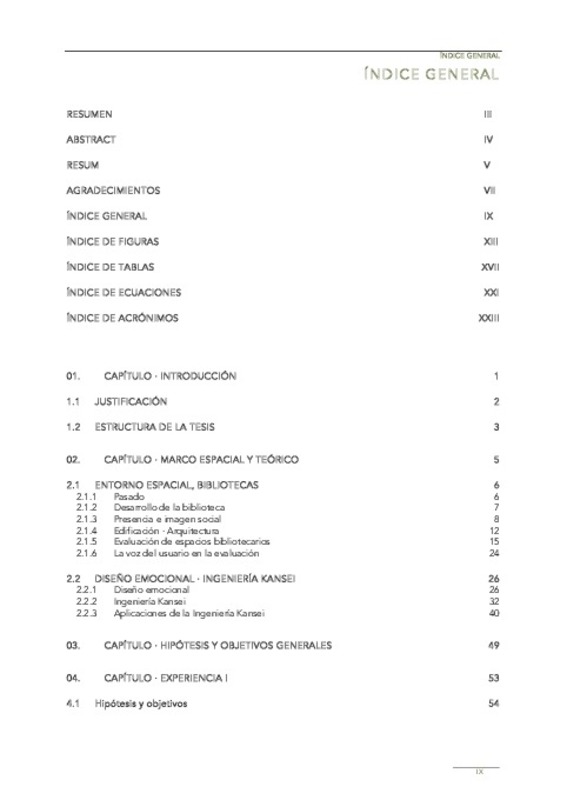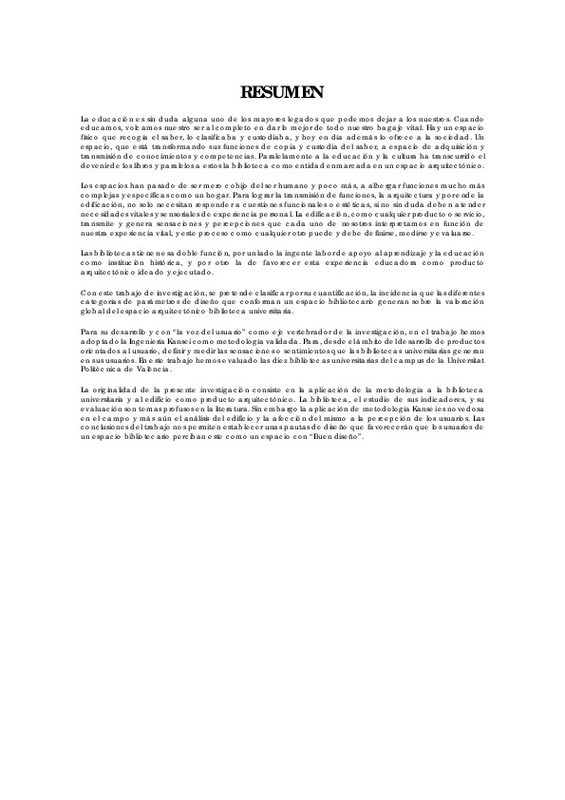- RiuNet repositorio UPV
- :
- Investigación
- :
- Tesis doctorales
- :
- Ver ítem
JavaScript is disabled for your browser. Some features of this site may not work without it.
Buscar en RiuNet
Listar
Mi cuenta
Estadísticas
Ayuda RiuNet
Admin. UPV
TAXONOMÍA CUANTIFICADA DEL DISEÑO EN LAS PERCEPCIONES DE BIBLIOTECAS UNIVERSITARIAS
Mostrar el registro sencillo del ítem
Ficheros en el ítem
| dc.contributor.advisor | Llinares Millán, María del Carmen
|
es_ES |
| dc.contributor.advisor | Montañana i Aviñó, Antoni
|
es_ES |
| dc.contributor.author | Fernández Plazaola, Igor
|
es_ES |
| dc.date.accessioned | 2017-09-01T07:32:02Z | |
| dc.date.available | 2017-09-01T07:32:02Z | |
| dc.date.created | 2017-07-03 | es_ES |
| dc.date.issued | 2017-09-01 | es_ES |
| dc.identifier.uri | http://hdl.handle.net/10251/86191 | |
| dc.description.abstract | Education is undoubtedly one of the greatest legacies we can leave to our own. When we educate, we turn our whole being into giving the others the best of all our vital spirit. There is a physical space that collected, classified and guarded knowledge, and nowadays also offers it to society. A space that is transforming its functions from copy and custody of knowledge to space of acquisition and transmission of knowledge and skills. Books life has been parallel to education and culture, and libraries as entities framed in an architectural space are parallel to these. Spaces have gone from being no more than a mere shelter of the human being, to host much more complex and specific functions as a home. To achieve the transmission of functions, architecture and therefore buildings, not only need to respond to functional or aesthetic issues, but also certainly must meet vital and sensory needs of personal experience. Building, like any other product or service, transmits and generates sensations and perceptions, that each of us interprets according to our life experience, and this process like any other, can and must be defined, measured and assessed. Libraries have this dual function, on the one hand the enormous work to support learning and education as a historical institution, and on the other, to foster this educational experience as an architectural product designed and executed. This research work intends to classify, by its quantification, the incidence that the different categories of design parameters that make up a library space, generate on the global valuation of architectural space university library. For its development and with the "voice of the user" as the backbone of the research, we have adopted the Kansei Engineering as a validated methodology. So, from the scope of user-oriented product development define and measure the feelings or perceptions that university libraries generate in their users. In this thesis, we have evaluated the ten university libraries of the campus of the Universitat Politècnica de València. The originality of the present research consists in the application of the methodology to the university library and to the building as an architectural product. The library, the study of its indicators, and its evaluation are profuse topics in the literature. However, the application of Kansei methodology is novel in the field and even more the analysis of the building and its affection to the perception of the users. The conclusions of the thesis allows us to establish a pattern of design parameters that will favour the users of a library space to perceive it as a space with "Good design". | en_EN |
| dc.description.abstract | La educación es sin duda alguna uno de los mayores legados que podemos dejar a los nuestros. Cuando educamos, volcamos nuestro ser al completo en dar lo mejor de todo nuestro bagaje vital. Hay un espacio físico que recogía el saber, lo clasificaba y custodiaba, y hoy en día además lo ofrece a la sociedad. Un espacio, que está transformando sus funciones de copia y custodia del saber, a espacio de adquisición y transmisión de conocimientos y competencias. Paralelamente a la educación y la cultura ha transcurrido el devenir de los libros y paralelos a estos la biblioteca como entidad enmarcada en un espacio arquitectónico. Los espacios han pasado de ser mero cobijo del ser humano y poco más, a albergar funciones mucho más complejas y específicas como un hogar. Para lograr la transmisión de funciones, la arquitectura y por ende la edificación, no solo necesitan responder a cuestiones funcionales o estéticas, si no sin duda deben atender necesidades vitales y sensoriales de experiencia personal. La edificación, como cualquier producto o servicio, transmite y genera sensaciones y percepciones que cada uno de nosotros interpretamos en función de nuestra experiencia vital, y este proceso como cualquier otro puede y debe definirse, medirse y evaluarse. Las bibliotecas tienen esa doble función, por un lado la ingente labor de apoyo al aprendizaje y la educación como institución histórica, y por otro la de favorecer esta experiencia educadora como producto arquitectónico ideado y ejecutado. Con este trabajo de investigación, se pretende clasificar por su cuantificación, la incidencia que las diferentes categorías de parámetros de diseño que conforman un espacio bibliotecario generan sobre la valoración global del espacio arquitectónico biblioteca universitaria. Para su desarrollo y con "la voz del usuario" como eje vertebrador de la investigación, en el trabajo hemos adoptado la Ingeniería Kansei como metodología validada. Para, desde el ámbito del desarrollo de productos orientados al usuario, definir y medir las sensaciones o sentimientos que las bibliotecas universitarias generan en sus usuarios. En este trabajo hemos evaluado las diez bibliotecas universitarias del campus de la Universitat Politècnica de València. La originalidad de la presente investigación consiste en la aplicación de la metodología a la biblioteca universitaria y al edificio como producto arquitectónico. La biblioteca, el estudio de sus indicadores, y su evaluación son temas profusos en la literatura. Sin embargo la aplicación de metodología Kansei es novedosa en el campo y más aún el análisis del edificio y la afección del mismo a la percepción de los usuarios. Las conclusiones del trabajo nos permiten establecer unas pautas de diseño que favorecerán que los usuarios de un espacio bibliotecario perciban este como un espacio con "Buen diseño". | es_ES |
| dc.description.abstract | L'educació és sens dubte un dels majors llegats que podem deixar als nostres. Quan eduquem, bolquem el nostre ser al complet donant el millor de tot el nostre bagatge vital. Hi ha un espai físic que arreplegava el saber, ho classificava i custodiava i hui en dia a més a més l'ofereix a la societat. Un espai que està transformant les seues funcions de còpia i custòdia del saber a espai d'adquisició i transmissió de coneixements i competències. Paral·lelament a l'educació i la cultura ha transcorregut l'esdevindre dels llibres i paral·lels a estos la biblioteca com a entitat emmarcada en un espai arquitectònic. Els espais han passat de ser mer recer del ser humà i poc més, a albergar funcions molt més complexes i específiques com pot ser una llar. Per a aconseguir la transmissió de funcions, l'arquitectura i per tant l'edificació, no sols necessiten respondre a qüestions funcionals o estètiques, si no sens dubte han d'atendre necessitats vitals i sensorials d'experiència personal. L'edificació, com qualsevol producte o servici, transmet i genera sensacions i percepcions que cada ú de nosaltres interpretem en funció de la nostra experiència vital, i este procés, com qualsevol altre pot i ha de definir-se, mesurar-se i avaluar-se. Les biblioteques tenen eixa doble funció, per un costat la ingent labor de suport a l'aprenentatge i l'educació com a institució històrica, i per un altre la d'afavorir esta experiència educadora com a producte arquitectònic ideat i executat. Amb este treball d'investigació, es pretén classificar per la seua quantificació, la incidència que les diferents categories de paràmetres de disseny que conformen un espai bibliotecari generen sobre la valoració global de l'espai arquitectònic biblioteca universitària. Per al seu desenrotllament i amb la "veu de l'usuari" com a eix vertebrador de la investigació, en el treball hem adoptat l'Enginyeria Kansei com a metodologia validada. Per a, des de l'àmbit del desenrotllament de productes orientats a l'usuari, definir i mesurar les sensacions o sentiments que les biblioteques universitàries generen en els seus usuaris. En este treball hem avaluat les deu biblioteques universitàries del campus de la Universitat Politècnica de València. L'originalitat de la present investigació consisteix en l'aplicació de la metodologia a la biblioteca universitària i a l'edifici com a producte arquitectònic. La biblioteca, l'estudi dels seus indicadors, i la seua avaluació són temes profusos en la literatura, no obstant això l'aplicació de metodologia Kansei és nova en el camp i més encara l'anàlisi de l'edifici i l'afecció del mateix a la percepció dels usuaris. Les conclusions del treball ens permeten establir unes pautes de disseny que afavoriran que els usuaris d'un espai bibliotecari perceben este com un espai amb "Bon disseny". | ca_ES |
| dc.language | Español | es_ES |
| dc.publisher | Universitat Politècnica de València | es_ES |
| dc.rights | Reserva de todos los derechos | es_ES |
| dc.subject | Ingeniería Kansei | es_ES |
| dc.subject | Bibliotecas universitarias | es_ES |
| dc.subject | Diseño emocional | es_ES |
| dc.subject | Voz del usuario | es_ES |
| dc.subject | Cuantificación de percepciones | es_ES |
| dc.subject.classification | ORGANIZACION DE EMPRESAS | es_ES |
| dc.title | TAXONOMÍA CUANTIFICADA DEL DISEÑO EN LAS PERCEPCIONES DE BIBLIOTECAS UNIVERSITARIAS | es_ES |
| dc.type | Tesis doctoral | es_ES |
| dc.identifier.doi | 10.4995/Thesis/10251/86191 | es_ES |
| dc.rights.accessRights | Abierto | es_ES |
| dc.contributor.affiliation | Universitat Politècnica de València. Escuela Técnica Superior de Arquitectura - Escola Tècnica Superior d'Arquitectura | es_ES |
| dc.description.bibliographicCitation | Fernández Plazaola, I. (2017). TAXONOMÍA CUANTIFICADA DEL DISEÑO EN LAS PERCEPCIONES DE BIBLIOTECAS UNIVERSITARIAS [Tesis doctoral]. Universitat Politècnica de València. https://doi.org/10.4995/Thesis/10251/86191 | es_ES |
| dc.description.accrualMethod | TESIS | es_ES |
| dc.type.version | info:eu-repo/semantics/acceptedVersion | es_ES |
| dc.relation.pasarela | TESIS\7357 | es_ES |
Este ítem aparece en la(s) siguiente(s) colección(ones)
-
Tesis doctorales [5389]










